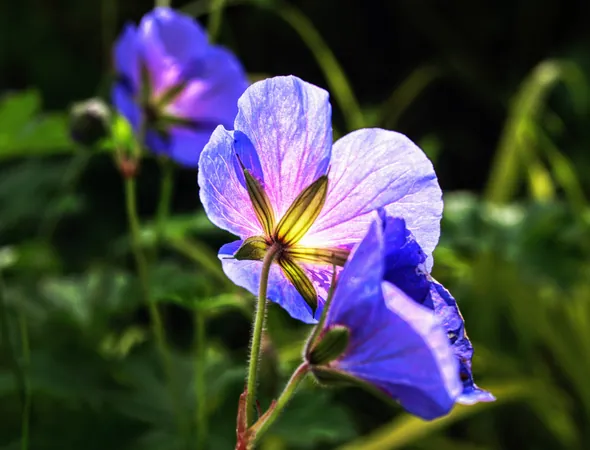
Discovering the Secrets of Plant Evolution: New Insights from Amborella
2024-11-26
Author: Ming
Plant reproduction plays a critical role in the health of our ecosystems and the food systems we depend on. Yet, the complexities behind it, such as varying gender roles among species—where some are male, female, or hermaphroditic, and some can even change sex—remain largely unexplored.
In a groundbreaking study published in the journal *Nature Plants*, scientists have shed light on the intricate reproduction mechanisms of flowering plants, particularly focusing on *Amborella trichopoda*, a species that offers a rare window into the early stages of flowering plant evolution.
Unlocking the Amborella Genome
Led by researchers from the HudsonAlpha Institute for Biotechnology and the University of Georgia, this study proudly unveils an advanced assembly of the *Amborella* genome and its sex chromosomes. This remarkable plant is the only extant member of a lineage that diverged from all other flowering plants around 150 million years ago. Therefore, its genetic information provides key insights into plant diversity and evolution.
The initial genomic work surrounding *Amborella* was completed by an international team over a decade ago. The findings from this effort were monumental, being cited over 575 times, and formed the basis for comparative studies tracing backward through the evolutionary timeline of flowering plants.
New Revelations in Flower Evolution
The enhanced genome assembly has been particularly significant for HudsonAlpha Faculty Investigator Alex Harkess, who was deeply involved in the first genomic project. Now leading his lab, he collaborated with a dynamic team—including PhD student Sarah Carey and other experts—to delve into the evolutionary intricacies of *Amborella*.
The new genome offers not just profound insights into floral evolution but also influences the direction of ongoing research, affording scientists a better grasp of how species diversify their reproductive strategies.
Cutting-Edge Technology in Plant Research
Utilizing advanced sequencing techniques and next-generation computational tools, the team successfully created a much-improved reference genome for *Amborella*. This breakthrough facilitated a streamlined search for the plant's unique sex chromosomes—Z and W—distinguished from the human X and Y chromosomes.
Thanks to innovations in long-read sequencing and the integration of Hi-C data, they were able to overcome earlier challenges presented by fragmented DNA segments. The developments included a novel computational method called cytogenetics-by-sequencing, which allows for more efficient identification of sex chromosomes in numerous species, encompassing almost 30 dioecious plant and animal species.
Insights into Sex Determination Mechanisms
One striking finding from the analysis of *Amborella*’s sex chromosomes is that the Z and W chromosomes are relatively young, arising long after the species branched off from its flowering plant relatives. While setbacks in recombination can occur colloquially in sex-determining systems, a recognizably unique pattern has emerged in *Amborella*’s ZW chromosomes that presents new avenues for exploration.
The researchers were able to isolate two key genes hypothesized to steer the sex determination in this singular species. This discovery could potentially reshape our understanding of how reproductive diversity is maintained in plants.
Implications for Agriculture and Plant Breeding
The ramifications of these findings extend far beyond scientific curiosity; they present exciting possibilities for agriculture. As Harkess aptly notes, understanding how to maintain separate sexes among plants opens new avenues for innovative breeding methods that could lead to enhanced crop yield, improved biodiversity, and heightened food security.
This research forms a crucial part of the Open Green Genomes Initiative, aimed at bridging the gaps in available genomic references for land plants. As scientists continue to unravel the genetic mechanisms that underlie plant reproduction, the potential applications for agriculture and conservation are indeed promising.
The Future is Green
By decoding the complexities of sex determination in plants, researchers can pioneer new strategies in plant breeding, which could transform agriculture for generations to come. This study not only enhances our understanding of plant evolution but also heralds a new era of possibilities for sustainable agriculture and ecosystem preservation.
Stay tuned for more captivating developments in the world of plant science and our ongoing quest to understand the natural world!



 Brasil (PT)
Brasil (PT)
 Canada (EN)
Canada (EN)
 Chile (ES)
Chile (ES)
 España (ES)
España (ES)
 France (FR)
France (FR)
 Hong Kong (EN)
Hong Kong (EN)
 Italia (IT)
Italia (IT)
 日本 (JA)
日本 (JA)
 Magyarország (HU)
Magyarország (HU)
 Norge (NO)
Norge (NO)
 Polska (PL)
Polska (PL)
 Schweiz (DE)
Schweiz (DE)
 Singapore (EN)
Singapore (EN)
 Sverige (SV)
Sverige (SV)
 Suomi (FI)
Suomi (FI)
 Türkiye (TR)
Türkiye (TR)